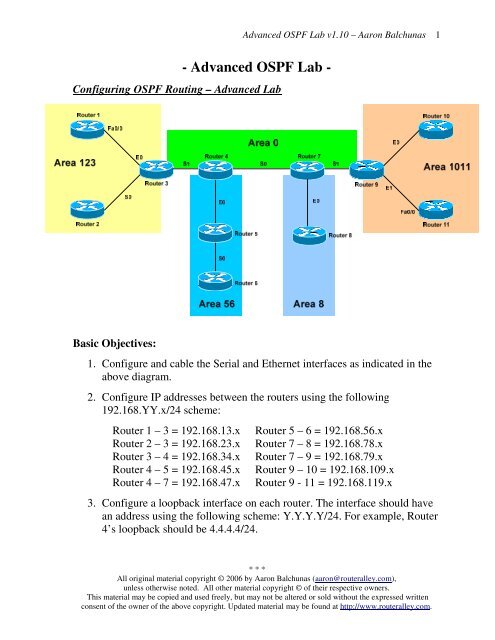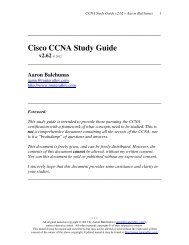Advanced OSPF Lab - Router Alley
Advanced OSPF Lab - Router Alley
Advanced OSPF Lab - Router Alley
Create successful ePaper yourself
Turn your PDF publications into a flip-book with our unique Google optimized e-Paper software.
<strong>Advanced</strong> <strong>OSPF</strong> <strong>Lab</strong> v1.10 – Aaron Balchunas<br />
1<br />
- <strong>Advanced</strong> <strong>OSPF</strong> <strong>Lab</strong> -<br />
Configuring <strong>OSPF</strong> Routing – <strong>Advanced</strong> <strong>Lab</strong><br />
Basic Objectives:<br />
1. Configure and cable the Serial and Ethernet interfaces as indicated in the<br />
above diagram.<br />
2. Configure IP addresses between the routers using the following<br />
192.168.YY.x/24 scheme:<br />
<strong>Router</strong> 1 – 3 = 192.168.13.x<br />
<strong>Router</strong> 2 – 3 = 192.168.23.x<br />
<strong>Router</strong> 3 – 4 = 192.168.34.x<br />
<strong>Router</strong> 4 – 5 = 192.168.45.x<br />
<strong>Router</strong> 4 – 7 = 192.168.47.x<br />
<strong>Router</strong> 5 – 6 = 192.168.56.x<br />
<strong>Router</strong> 7 – 8 = 192.168.78.x<br />
<strong>Router</strong> 7 – 9 = 192.168.79.x<br />
<strong>Router</strong> 9 – 10 = 192.168.109.x<br />
<strong>Router</strong> 9 - 11 = 192.168.119.x<br />
3. Configure a loopback interface on each router. The interface should have<br />
an address using the following scheme: Y.Y.Y.Y/24. For example, <strong>Router</strong><br />
4’s loopback should be 4.4.4.4/24.<br />
* * *<br />
All original material copyright © 2006 by Aaron Balchunas (aaron@routeralley.com),<br />
unless otherwise noted. All other material copyright © of their respective owners.<br />
This material may be copied and used freely, but may not be altered or sold without the expressed written<br />
consent of the owner of the above copyright. Updated material may be found at http://www.routeralley.com.
<strong>Advanced</strong> <strong>OSPF</strong> <strong>Lab</strong> v1.10 – Aaron Balchunas<br />
2<br />
Configuring <strong>OSPF</strong> Routing – <strong>Advanced</strong> <strong>Lab</strong> (continued)<br />
<strong>OSPF</strong> Objectives:<br />
4. Configure <strong>OSPF</strong> on all routers. Use whatever process ID you wish.<br />
___________________________________________________________<br />
___________________________________________________________<br />
___________________________________________________________<br />
5. Manually set the <strong>OSPF</strong> router-ID on your router to your loopback IP.<br />
___________________________________________________________<br />
___________________________________________________________<br />
___________________________________________________________<br />
6. Place each interface on your router into the Area specified by the diagram.<br />
Place loopback interfaces in whatever area is easiest.<br />
___________________________________________________________<br />
___________________________________________________________<br />
___________________________________________________________<br />
* * *<br />
All original material copyright © 2006 by Aaron Balchunas (aaron@routeralley.com),<br />
unless otherwise noted. All other material copyright © of their respective owners.<br />
This material may be copied and used freely, but may not be altered or sold without the expressed written<br />
consent of the owner of the above copyright. Updated material may be found at http://www.routeralley.com.
<strong>Advanced</strong> <strong>OSPF</strong> <strong>Lab</strong> v1.10 – Aaron Balchunas<br />
3<br />
Configuring <strong>OSPF</strong> Routing – <strong>Advanced</strong> <strong>Lab</strong> (continued)<br />
<strong>OSPF</strong> Objectives:<br />
7. Configure <strong>OSPF</strong> md5 authentication throughout your <strong>OSPF</strong> domain. Use<br />
a key of “CISCO” between all neighbors.<br />
___________________________________________________________<br />
___________________________________________________________<br />
___________________________________________________________<br />
8. Area 123 and Area 8 should not accept Type 3, 4, or 5 LSAs. Area 56 and<br />
Area 1011 should not accept Type 4 or 5 LSAs. However, all areas should<br />
accept Type 7 LSA’s.<br />
___________________________________________________________<br />
___________________________________________________________<br />
___________________________________________________________<br />
___________________________________________________________<br />
___________________________________________________________<br />
___________________________________________________________<br />
___________________________________________________________<br />
___________________________________________________________<br />
___________________________________________________________<br />
* * *<br />
All original material copyright © 2006 by Aaron Balchunas (aaron@routeralley.com),<br />
unless otherwise noted. All other material copyright © of their respective owners.<br />
This material may be copied and used freely, but may not be altered or sold without the expressed written<br />
consent of the owner of the above copyright. Updated material may be found at http://www.routeralley.com.
<strong>Advanced</strong> <strong>OSPF</strong> <strong>Lab</strong> v1.10 – Aaron Balchunas<br />
4<br />
Configuring <strong>OSPF</strong> Routing – <strong>Advanced</strong> <strong>Lab</strong> (continued)<br />
<strong>OSPF</strong> Objectives:<br />
9. Ensure that all networks are reachable.<br />
___________________________________________________________<br />
___________________________________________________________<br />
10. On each router, create a loopback interface with the following address<br />
66.XX.1.1/16, where XX is your router number.<br />
___________________________________________________________<br />
___________________________________________________________<br />
11. Create static routes on each router to the following networks, and set a<br />
next hop of 66.XX.1.2:<br />
77.XX.0.0/24, 77.XX.1.0/24, 77.XX.2.0/24, 77.XX.3.0/24<br />
___________________________________________________________<br />
___________________________________________________________<br />
___________________________________________________________<br />
___________________________________________________________<br />
___________________________________________________________<br />
* * *<br />
All original material copyright © 2006 by Aaron Balchunas (aaron@routeralley.com),<br />
unless otherwise noted. All other material copyright © of their respective owners.<br />
This material may be copied and used freely, but may not be altered or sold without the expressed written<br />
consent of the owner of the above copyright. Updated material may be found at http://www.routeralley.com.
<strong>Advanced</strong> <strong>OSPF</strong> <strong>Lab</strong> v1.10 – Aaron Balchunas<br />
5<br />
Configuring <strong>OSPF</strong> Routing – <strong>Advanced</strong> <strong>Lab</strong> (continued)<br />
<strong>OSPF</strong> Objectives:<br />
12. Redistribute these static routes into the <strong>OSPF</strong> process. Check your routing<br />
tables to ensure these routes have propagated.<br />
___________________________________________________________<br />
___________________________________________________________<br />
___________________________________________________________<br />
___________________________________________________________<br />
13. Configure <strong>OSPF</strong> to summarize these redistributed routes into a single<br />
route. However, you still want the 77.XX.1.0 network to be advertised<br />
individually.<br />
___________________________________________________________<br />
___________________________________________________________<br />
___________________________________________________________<br />
___________________________________________________________<br />
___________________________________________________________<br />
___________________________________________________________<br />
___________________________________________________________<br />
___________________________________________________________<br />
* * *<br />
All original material copyright © 2006 by Aaron Balchunas (aaron@routeralley.com),<br />
unless otherwise noted. All other material copyright © of their respective owners.<br />
This material may be copied and used freely, but may not be altered or sold without the expressed written<br />
consent of the owner of the above copyright. Updated material may be found at http://www.routeralley.com.

















